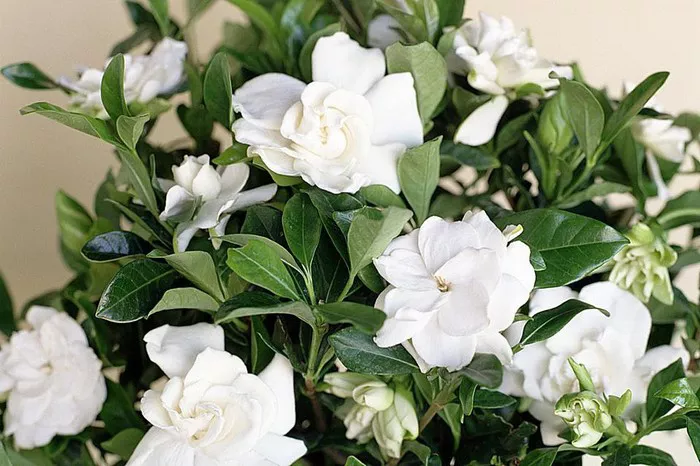Gardenias, with their lush evergreen foliage and immaculate, fragrant blossoms, have long been revered for their ethereal beauty and captivating fragrance. Belonging to the Rubiaceae family, these elegant flowers are native to tropical and subtropical regions of Asia, Africa, and Oceania. Gardenias, often referred to as Cape jasmine, are celebrated for their ornamental value and symbolic significance. In this comprehensive exploration, we delve into the enchanting world of gardenia flowers, uncovering their symbolism, exploring the diverse types available, and offering invaluable insights into their cultivation and care.
Types of Gardenia Flowers:
Gardenias encompass a rich diversity of species and cultivars, each possessing its unique charm and characteristics. Some of the most prominent types of gardenia flowers include:
1. Gardenia jasminoides: This species, commonly known as Cape jasmine, stands out for its glossy, dark green foliage and large, creamy-white blossoms. With their intoxicating scent and timeless elegance, Gardenia jasminoides remains a perennial favorite among gardeners and floral enthusiasts alike.
2. Gardenia thunbergia: Hailing from South Africa, Gardenia thunbergia showcases smaller, star-shaped flowers and a compact growth habit. Renowned for its resilience and adaptability, this species thrives in diverse climates, adding a touch of understated beauty to any landscape.
3. Gardenia augusta: The dwarf gardenia, as it is affectionately known, is prized for its diminutive stature and profusion of blooms. Ideal for smaller gardens or container cultivation, Gardenia augusta exudes charm and elegance in abundance, captivating all who behold its delicate allure.
4. Gardenia radicans: This low-growing cultivar, distinguished by its creeping habit, is a versatile choice for ground cover or edging. With its petite, fragrant flowers and compact form, Gardenia radicans lends a touch of whimsy and romance to any garden setting.
Gardenia Flower Symbolism:
Gardenia flowers hold a profound symbolic significance across various cultures and traditions, embodying a myriad of emotions and sentiments. Here are some of the most prevalent interpretations associated with gardenias:
1. Purity and Innocence: With their pristine white petals and sweet fragrance, gardenias symbolize purity, innocence, and youthfulness. Often used in bridal bouquets and religious ceremonies, these exquisite blooms evoke a sense of divine beauty and untainted virtue.
2. Love and Romance: Gardenias are synonymous with love and romance, serving as poignant expressions of deep affection and passion. Whether presented as a token of admiration or adorning a lover’s corsage, these fragrant blossoms speak volumes of heartfelt sentiment and ardor.
3. Secret Love: In certain cultures, gardenias are associated with clandestine or unrequited love, imbuing them with an air of mystery and longing. Offering a gardenia to a secret admirer conveys hidden desires and unspoken yearnings, shrouded in the delicate beauty of these enigmatic flowers.
4. Mystery and Sensuality: The intoxicating scent of gardenias exudes an aura of mystery and sensuality, captivating the senses and stirring the imagination. Often utilized in perfumery and aromatherapy, these alluring blooms evoke feelings of passion, intrigue, and desire.
5. Hope and Renewal: As harbingers of spring, gardenias symbolize hope, renewal, and new beginnings. Their fragrant blossoms herald the arrival of warmer weather and the promise of growth and prosperity, instilling a sense of optimism and anticipation in all who encounter them.
How to Care for Gardenia Flowers:
While gardenias exude unparalleled beauty and fragrance, they require meticulous care to thrive and flourish. Here are some essential tips for cultivating healthy and vibrant gardenia plants:
1. Optimal Location: Plant gardenias in a location with partial shade to protect them from intense sunlight, particularly during the hottest part of the day. Ensure the soil is well-drained and rich in organic matter, with a slightly acidic pH level ideally between 5.0 and 6.0.
2. Regular Watering: Maintain consistent soil moisture by watering gardenias deeply and regularly, particularly during periods of hot, dry weather. Avoid overwatering, as excessive moisture can lead to root rot and other fungal diseases. Mulching around the base of the plant helps retain moisture and suppress weeds.
3. Fertilization: Feed gardenias with a balanced, slow-release fertilizer formulated for acid-loving plants. Apply fertilizer sparingly, following the manufacturer’s instructions, to avoid overfeeding and potential damage to the plant. Fertilize gardenias in spring and again in midsummer to promote vigorous growth and abundant flowering.
4. Pruning and Maintenance: Prune gardenias selectively after flowering to remove spent blooms and maintain a compact, bushy shape. Avoid heavy pruning, as it can diminish flowering and weaken the plant over time. Remove any dead or diseased branches promptly to prevent the spread of pests and diseases.
5. Pest and Disease Management: Monitor gardenias regularly for common pests such as aphids, scale insects, and whiteflies, which can infest the foliage and weaken the plant. Treat infestations promptly with insecticidal soap or neem oil, taking care to cover both the upper and lower surfaces of the leaves. Additionally, watch for signs of fungal diseases such as powdery mildew and leaf spot, and apply fungicides as needed to protect the plant’s health.
6. Winter Protection: In colder climates, provide winter protection for gardenias to safeguard them from frost damage. Cover plants with frost cloth or burlap when temperatures drop below freezing, and consider bringing potted gardenias indoors to a sheltered location. Apply a layer of mulch around the base of the plant to insulate the roots and protect them from temperature fluctuations.
Conclusion
In conclusion, gardenia flowers enchant and inspire with their timeless beauty and profound symbolism, serving as potent reminders of love, purity, and hope. By understanding their cultural significance and providing attentive care, gardeners can cultivate flourishing gardenia plants that grace their gardens and homes with unparalleled elegance and fragrance. Embrace the allure of gardenias, and embark on a journey of botanical enchantment that transcends time and space.


